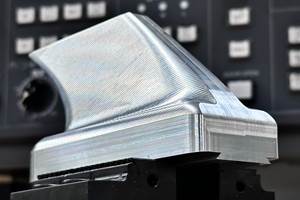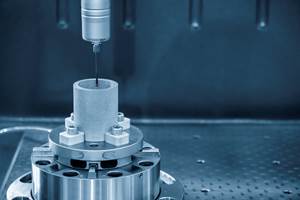Up To 12 Tools In One Holder
Imagine a single cutting toolholder that can be used to perform 12 distinct metalcutting operations without a tool change. That's the concept behind a new cutting tool innovation designed and built by Mazak.
Share





Imagine a single cutting toolholder that can be used to perform 12 distinct metalcutting operations without a tool change. That's the concept behind a new cutting tool innovation designed and built by Mazak (Florence, Kentucky).
It's called Flash Tool holder, and it is designed to complement the capabilities of the company's multitasking Integrex series of machine tools. Integrex is a turning center-based machine that uses a swivel milling head to perform fixed tool operations while rotating the workpiece or rotary tool operations with the workpiece stationary. It can also do C-axis contouring by rotating the part and milling cutter simultaneously.
The process advantage of the Integrex machine is its ability to completely machine complex workpieces in a single handling. It uses a synchronized main spindle and subspindle to present all workpiece features for first and second operations to the swivel milling head.
Like any tool changing machine, such as a machining center or turning center, reducing tool changes is an efficient method of optimizing cycle times. An example on machining centers is using combination tools that perform drilling and tapping in one cutter to help increase spindle utilization. Rather than change tools, one cutter does two or more operations. Over a medium part run, the time savings from reduced tool changes can be significant.
Likewise, reducing the number of turret indexes on a turning center ups the time in the cut. If the same cutting tool can be used to rough face and rough turn, the time savings from reducing turret indexes add up over the run of parts.
Mazak designed the Flash Tool holder to combine up to 12 cutting operations in a single holder. It's important to note that this tool will not work without the rotary and swivel positioning capabilities of the Integrex milling head. They are a system.
The standard Flash Tool holder uses a four-flute shank. The key to this cutter is that each insert in each flute is different. Each insert is clamped in a pre-milled pocket in the toolholder. For rotary operations including milling, chamfering and drilling, the outside inserts do the cutting. They are located on the nominal or major OD. Other inserts with different nominal OD are used to perform rough and finish turning, threading and ID work.
It's the milling head that is able to bring these inserts accurately to bear on the workpiece by changing the effective geometry of the insert. On turning operations, changing the angle of inclination of a given insert by swiveling the B-axis allows more or less of the insert edge to be engaged in the cut. A wide edge can be used for roughing, or a single point can be used for threading. The milling head indexes and locks in 24 positions in 15-degree increments.
Depending on the application, and its tooling requirements, the Flash Tool concept can be used to carry a large variety of inserts. Besides the standard four, tool holders can be used that have two, three or six different inserts.
Flash Tool holding is an interesting innovation that makes an individual multi-flute cutter into a veritable tool storage unit. It represents a tooling strategy that would be impossible without the advances in multitasking machine tools.
Related Content
Shoulder Milling Cuts Racing Part's Cycle Time By Over 50%
Pairing a shoulder mill with a five-axis machine has cut costs and cycle times for one of TTI Machine’s parts, enabling it to support a niche racing community.
Read MoreCustom Workholding Principles to Live By
Workholding solutions can take on infinite forms and all would be correct to some degree. Follow these tips to help optimize custom workholding solutions.
Read MoreLean Approach to Automated Machine Tending Delivers Quicker Paths to Success
Almost any shop can automate at least some of its production, even in low-volume, high-mix applications. The key to getting started is finding the simplest solutions that fit your requirements. It helps to work with an automation partner that understands your needs.
Read MoreParts and Programs: Setup for Success
Tips for program and work setups that can simplify adjustments and troubleshooting.
Read MoreRead Next
Last Chance! 2025 Top Shops Benchmarking Survey Still Open Through April 30
Don’t miss out! 91ÊÓƵÍøÕ¾ÎÛ's Top Shops Benchmarking Survey is still open — but not for long. This is your last chance to a receive free, customized benchmarking report that includes actionable feedback across several shopfloor and business metrics.
Read MoreAMRs Are Moving Into Manufacturing: 4 Considerations for Implementation
AMRs can provide a flexible, easy-to-use automation platform so long as manufacturers choose a suitable task and prepare their facilities.
Read MoreMachine Shop MBA
Making Chips and 91ÊÓƵÍøÕ¾ÎÛ are teaming up for a new podcast series called Machine Shop MBA—designed to help manufacturers measure their success against the industry’s best. Through the lens of the Top Shops benchmarking program, the series explores the KPIs that set high-performing shops apart, from machine utilization and first-pass yield to employee engagement and revenue per employee.
Read More






















